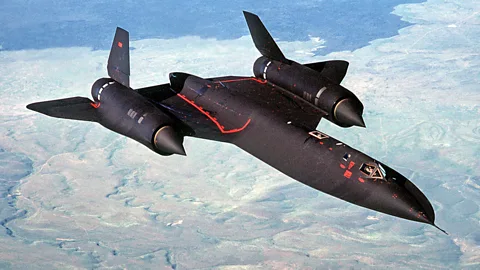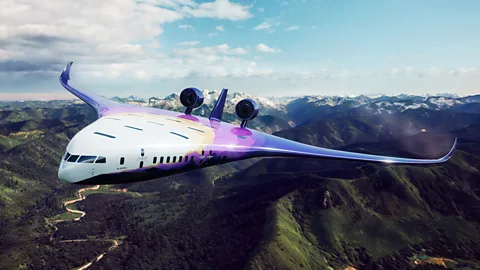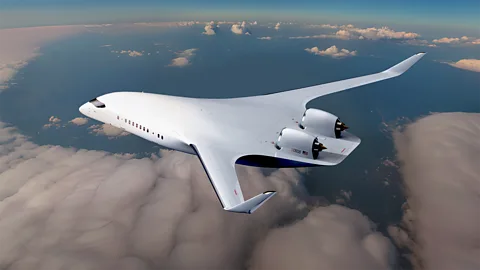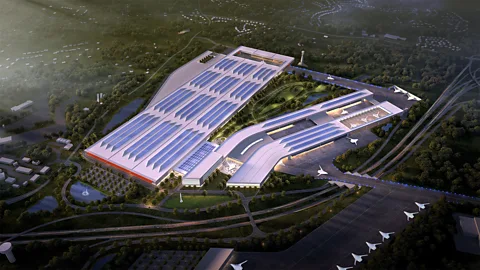
 Outbound
Outbound
(Credit: Outbound)
The concept of blended-wing aircraft – where fuselage and wing are all one structure – is not new. But this radical design might soon be a credible concept for airliners.
In March 2025, a small V-shaped remote-controlled aircraft took off for the first time from the Pendleton UAS Range in eastern Oregon. Codenamed Steve (for Scaled Test Vehicle), the unmanned vehicle flew for only 16 seconds on its first flight, but that didn't matter.
Steve's first and subsequent flights were the first steps on a path that its creator, Outbound Aerospace, hopes will lead to the launch of a radical new 200 to 250-seat blended-wing airliner in the 2030s. With a 171ft (52m) wingspan around eight times that of Steve – this airliner that has already been named the Olympic.
The idea that the wings and fuselage of an aircraft can be smoothly blended, with no clear dividing line, to increase aerodynamic efficiency dates back more than 100 years. In 1924, the first recorded blended-wing aircraft made its first flight – and then crashed.
Since then, blended-wing technology has primarily been left to the US military to develop for their bombers. Now the aviation industry's pressing need to reduce emissions may mean the time has come for the first blended-wing commercial airliner. But can startups like Outbound Aerospace overcome the serious challenges that remain?

 Getty Images
Getty Images
Steve's flights are intended to show the Seattle-based startup's innovative blended-wing aircraft design works, and that the company's "novel" manufacturing technology can deliver the new type of mid-market airliner faster and cheaper than the current big plane-makers like Airbus and Boeing.
"We went from a clean sheet design to a demonstrator in about 12 months," says Jake Armenta, a former Boeing engineer, and co-founder and chief technology officer of Outbound Aerospace. He believes his team has shown they can cut down the 5-10 years or more it can take to develop a commercial aircraft. "The aircraft flying for the first time was exactly nine months from the day we opened our factory doors for the first time."
Now their technology demonstrator is finding a new use as a cargo drone.
"Now Steve has proved interesting to the US Department of Defense, and other, civilian customers, because it has a large cargo bay and could be cheaper than conventional designs. So that is the first product we're now bringing into market."
Outbound isn't the only company going down this road
"We believe we can drastically reduce the time and capital expense of the development of these aircraft but it's still going to be very expensive," adds Aaron Boysen, Outbound's director of business development. "We have to earn revenue earlier than 10 years down the road."
Despite scepticism from investors about the feasibility of their plans, Outbound has managed to raise around $1m (£765,000) in pre-seed funding so far. This money is the first investment a startup receives to turn ideas into reality, and it has allowed them to hire five full-time staff, contractors and part-timers as needed.
Outbound isn't the only company going down this road. There are at least two other start-ups in the race to build the first blended-wing airliner, which has been "a goal for so long that some people say it has become the 'holy grail of aviation'," says analyst and commentator Bill Sweetman.

 Outbound
Outbound
The gleaming computer-generated imagery of how the Olympic may look in the 2030s looks very different from the actual tube-and-wing airliners that Boeing and Airbus currently produce. Often called flying wings, these aircraft are more aerodynamically efficient than conventional airliners.
If a company can get a blended-wing design right then they argue that Nasa’s research suggests it might burn up to 50% less fuel by using the latest technology, reduce emissions by a similar amount, noise by a significant amount, do this with cabins that might be 40% larger, and, as a result, may conceivably open up new air routes. While seats near windows will be limited, there may be enough space for extra-large doors that would eliminate slow-moving queues of people waiting to board, as well as allow separate cabins for first-class, business and economy passengers.
Some advocates for this radical rethinking of the commercial airliner have bigger ambitions. They hope that start-ups such as Outbound and its rivals like JetZero and Nautilus will open up the airliner market to new designs that don't come from Airbus or Boeing, blaming this duopoly for stifling new ideas in the industry.
JetZero appears to have one of the highest profiles out of all the start-ups in the race to develop the first full-size blended-wing commercial airliner from a small-scale technology demonstrator. Based in Long Beach, California, it was awarded $235m (£74m) in funding from the United States Air Force (USAF) and further investment from United Airlines and Alaska Airlines to fund the development of its Z4. In addition, United Airlines has a"path" to ordering up to 200 Z4s if it meets the airlines requirements.
There is a great deal of interest now because there is a fever among the venture capitalists and tech bros to go out and disrupt as many fuddy-duddy old industries as they can find – Bill Sweetman
JetZero has also partnered with prominent aerospace companies including BAE, Northrup Grumman and engine makers Pratt & Whitney to develop the Z4. It has already flown its own small-scale Pathfinder I demonstrator and completed a critical design review. These are a formal evaluation of the final design to assess whether it is ready to manufacture.
Just before the Paris Airshow in June 2025, JetZero announced that it had chosen the site for its factory to build the Z4. It is in Greensboro, North Carolina, next door to the factory where another aviation startup, Boom, is building its supersonic airliner, which United plans to order if it meets its requirements. JetZero ambitiously plans to start flights with a full-size demonstrator as-early-as 2027.

 JetZero
JetZero
Outbound Aerospace's Boysen isn't fazed by his rivals' apparent progress. "The publicity around JetZero and their pre-orders helps us all because it gets blended-wing bodies into the conversation of airlines and industry," he says. "It means that they will face the two enormous costs of certification and public acceptance before us, and we will not have to incur those costs as steeply as they will."
Blended wing designs have been an ambition of many aircraft designers since the earliest days of aviation. "There is a great deal of interest now because there is a fever among the venture capitalists and tech bros to go out and disrupt as many fuddy-duddy old industries as they can find, and aviation is the next target," says Bill Sweetman.
"Advanced materials, computer aided design (CAD) and three-dimensional aerodynamics have all helped this new interest in blended-wing bodies.
The money these airlines are risking is change down the back of the sofa at this moment – Bill Sweetman
"There are people who would like to see a new competitor to Airbus and Boeing…the problem is the huge expense of getting this thing into production, and starting a new commercial aircraft company is such an enormous task."
But he is sceptical over the value of airline support for these projects, despite the funding announced so far. "The money these airlines are risking is change down the back of the sofa at this moment," adds Sweetman. "The orders they have made are contingent on these start-ups being able to deliver something they want. This is like a green halo effect; it's more about the airlines advertising their new thinking."
That said, starting with a small-scale flight demonstrator and going to a full-size demonstrator may be a good idea. "It will build a lot of confidence. But you can't build a production line for these things and just go into service with the small amount of testing that's been done now."

 Nasa
Nasa
The first recorded blended-wing aircraft to fly is the Westland Dreadnought in 1924. Based on the futuristic design ideas of Russian inventor Nicolas Woyevodsky, the eight-passenger Dreadnought crashed on its first flight due to instability and loss of control, badly injuring its pilot, and it was abandoned.
Since then, the complexity of the blended-wing design has meant this configuration has largely been left for the military to pioneer, with successful designs such as the Rockwell B1-B Lancer and Northrop's new B-21 Raider.
"It's quite complicated to get the design right because of the complex air flow around blended-wing aircraft," says Sweetman. "But it is relatively easy to do so if you are designing a bomber because they aren't large, pressurised spaces in there. The same is true for an air-refuelling tanker."
Much of the current wave of designs stems from Nasa's call in 1988 for revolutionary aircraft designs
Over the past 30 years, Nasa, Boeing, Airbus, Chinese aircraft manufacturer Comac and even Canadian business jet manufacturer Bombardier have all explored blended-wing layouts for commercial aviation. Their research teams have often done this by building small-scale test aircraft like Steve, testing them in wind tunnels and then flying them out in the real world.
Much of the current wave of designs stems from Nasa's call in 1988 for revolutionary aircraft designs. One team that responded included Robert Lieback who later became co-developer and project manager for Boeing's blended wing programmes. Their work on a futuristic blended-wing airliner eventually led to a remote-controlled aircraft designated the Boeing/Nasa X-48, which was named one of Time Magazine's top inventions in 2007. The X-48 may have been tiny, but it was designed to fly like a full-size plane.
The two X-48s built then embarked on a remarkable series of 120 flights over six years. These fights tested how blended-wing aircraft responded to problems such as the engines failing or stalling, as well as exploring ways to reduce fuel consumption and noise levels.

 JetZero
JetZero
The revolution the X-48 promised has yet to take off, however.
"Back in the day, Bob Liebeck was trying, very diligently, to overcome the practical problems of blended-wing bodied aircraft," says Sweetman. "Probably the biggest one is having to put a pressurised passenger cabin in there."
"Pressurised vessels tend to have circular cross-sections because flat surfaces experience very high loads under pressure, causing structural complications for any more box-like design. Then trying to design this around an appealing cabin was a further challenge.
"After McDonnell Douglas were taken over by Boeing, Liebeck started thinking that Boeing's next plane should be a blended-wing design instead of a 787," he adds. "Then the inquisition came down from Seattle to put a stop to this heresy."
We are questioning this status quo – Aaron Boysen
Outbound's Steve is intentionally the same size and dimensions as the X-48. "The X-48 programme proved that modern flight control systems could effectively manage a blended wing design," says Boysen. "But it was still expensive to build due to the complexities."
"We were able to build and fly Steve, an aircraft that matches the X-48, but on a fraction of that programme's budget and in only nine months," says Armenta.
He admits he has felt "attacked" by some investors when presenting Outbound's radical plans to them. But Boysen says the team "truly believe" that the only way to successfully develop and launch a radical new airliner like Olympic is not to become a Boeing 2.0 or Airbus 2.0.
"We are questioning this status quo," he says. "We have decided that to successfully build an entirely new aircraft we need to look at what we outsource and what we bring inside."
More like this:
• The aviation giant that doesn't yet exist
• The airship that may usher in a new age
• Can we really fuel planes with fat and sugar?
To this end they used advanced 3-D printing to make their own tooling and "prove" they could build a flyable aircraft out of carbon fibre and their demonstrator "way cheaper than anyone else," says Armenta.
"I think these are praiseworthy and sincere ventures," says Sweetman. "But what I see in a lot of these new projects is a sort of airy, 'We can do this, we are a new generation. Stop being negative grandpa.'
"Sure, you can be optimistic, but you really must look at where the obstacles are, how much money is it really going to take you to get a product that you can offer to an airline, how to deliver it and then how much to be able to deliver it at a profit."
Outbound is now busy turning Steve into the Gateway drone which it can sell in the meantime. After that, it has plans for an upgraded version with double the wingspan, an ultra-long-range business jet, and the Olympic, as well as even bigger airliner planned for the 2040s. But there will be plenty of challenges to overcome before then.
"There is a vast talent pool of aerospace engineers, managers and leaders here in Seattle who are, quite honestly, hungry for something new," says Boysen, "and that is why we are here."
--
.png)



